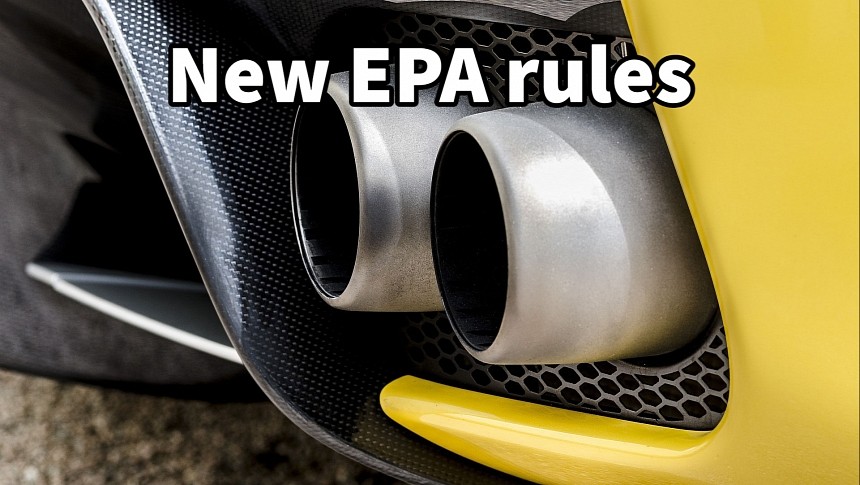The EPA proposed stricter vehicle emissions standards for 2027-2032 vehicles in a bid to accelerate EV adoption in the US. The agency aims for EVs to make up 67% of light-duty vehicle sales and 46% of medium-duty vehicle sales in the 2032 model year.
The EPA is using a carrot-and-stick strategy to accelerate EV adoption, setting up stricter emissions rules and, at the same time, offering federal incentives and other investments. The transportation sector is responsible for the bulk of harmful pollutants released into the atmosphere and the number one source of greenhouse gases. Making combustion engines less appealing with stricter regulations could push people toward buying an electric vehicle.
There are also benefits for those who stick with gas-powered vehicles, as the new regulations mean lower fuel consumption. The EPA expects the new rules to save consumers $12,000 over the lifetime of a light-duty vehicle compared to one that doesn't meet the new tailpipe pollution limits.
The emissions standards would increase in stringency every year until it reaches 82 grams per mile (52 grams per kilometer) of carbon dioxide in the 2032 model year. For medium-duty vehicles, the standards also become stricter over time, with an average target of 275 grams per mile (171 grams per kilometer) of CO2 by the 2032 model year. This represents a combined fleet year-over-year CO2 reduction of 18% in the 2027 model year, 13% in 2028, 15% in 2029, 8% in 2030, 9% in 2031, and 11% in 2032.
The combined fleet year-over-year CO2 reduction averages 13% over 2027-2032. This is significantly stricter than the 2023-2026 rule, which mandates an increase in stringency between 5% and 10% with each model year. Current standards require an industrywide target of 161 grams of CO2 per mile (or 40 mpg EPA rating) by the 2026 model year. The EPA aims to achieve a 56 percent reduction in greenhouse gas emissions for light-duty vehicles in the 2032 model year compared to the 2026 model year. For medium-duty vehicles, the reduction amounts to 44 percent.
The EPA also proposed more stringent greenhouse gas regulations for heavy-duty vocational vehicles, such as delivery trucks and school buses. The rule finalized in December covers the 2028-2032 model years. All those combined regulations are projected to prevent nearly 10 billion tons of CO2 emissions from being released into the atmosphere by 2055. Light- and medium-duty vehicles alone would account for 7.3 billion tons.
The EPA regulations fell short of imposing a ban on sales of new combustion-engine vehicles, something that California and the European Union have announced. Still, producing combustion vehicles to meet the stricter emissions regulations would be increasingly challenging. This would require expensive solutions like electrification, increasing the MSRP. At the same time, electric vehicles are set to become more affordable over time.
There are also benefits for those who stick with gas-powered vehicles, as the new regulations mean lower fuel consumption. The EPA expects the new rules to save consumers $12,000 over the lifetime of a light-duty vehicle compared to one that doesn't meet the new tailpipe pollution limits.
The emissions standards would increase in stringency every year until it reaches 82 grams per mile (52 grams per kilometer) of carbon dioxide in the 2032 model year. For medium-duty vehicles, the standards also become stricter over time, with an average target of 275 grams per mile (171 grams per kilometer) of CO2 by the 2032 model year. This represents a combined fleet year-over-year CO2 reduction of 18% in the 2027 model year, 13% in 2028, 15% in 2029, 8% in 2030, 9% in 2031, and 11% in 2032.
The combined fleet year-over-year CO2 reduction averages 13% over 2027-2032. This is significantly stricter than the 2023-2026 rule, which mandates an increase in stringency between 5% and 10% with each model year. Current standards require an industrywide target of 161 grams of CO2 per mile (or 40 mpg EPA rating) by the 2026 model year. The EPA aims to achieve a 56 percent reduction in greenhouse gas emissions for light-duty vehicles in the 2032 model year compared to the 2026 model year. For medium-duty vehicles, the reduction amounts to 44 percent.
The EPA also proposed more stringent greenhouse gas regulations for heavy-duty vocational vehicles, such as delivery trucks and school buses. The rule finalized in December covers the 2028-2032 model years. All those combined regulations are projected to prevent nearly 10 billion tons of CO2 emissions from being released into the atmosphere by 2055. Light- and medium-duty vehicles alone would account for 7.3 billion tons.
The EPA regulations fell short of imposing a ban on sales of new combustion-engine vehicles, something that California and the European Union have announced. Still, producing combustion vehicles to meet the stricter emissions regulations would be increasingly challenging. This would require expensive solutions like electrification, increasing the MSRP. At the same time, electric vehicles are set to become more affordable over time.






